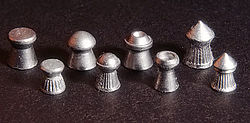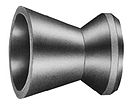- Pellet (air gun)
-
An air gun pellet is, for the most part, a non-spherical projectile designed to be fired from an air gun. But this is not always the case. Pellets differ from bullets used in firearms because of the pressures encountered; firearms operate at pressures of thousands of atmospheres, while airguns operate at pressures as low as 50 atmospheres. Firearms have sufficient pressure to force a slightly over-sized bullet to fit the bore in order to form a tight seal, while airguns generally use a slightly undersized projectile that is designed to obturate upon shooting so as to seal the bore, and engage the rifling. Since pellets may be shot through a smoothbore barrel, they are often designed to be inherently stable, much like the Foster slugs used in smoothbore shotguns.
The "diabolo," sometimes called wasp waist pellet is the most common design found today. The diabolo pellet can have a flat, round, hollow or pointed tip, followed by a taper to a thin waist. From the waist back, the pellet is hollow, and flares out to full diameter when pressurized by the gun. The head, or solid part in front of the waist, is usually sized to fit the bore just touching the rifling. This keeps the pellet centred in the bore, while keeping the friction as low as possible. The effect of friction is used in order to keep the pellet stationary until the piston has reached the end of its travel, compressing as much as air as is inherently possible. The skirt of the pellet is thin, and made of a malleable material, usually lead, although non-toxic alternatives are available that use tin or even plastic. When shot, the skirt will obturate to fit the bore and provide a good seal, and engage the rifling, whereby imparting spin. In a smoothbore barrel, the skirt will still flare to provide a tight seal, but since there is no rifling, the pellet will not spin, and is less accurate. In most cases of this type, the solid head in the front and hollow skirt in back will work to prevent the pellet from tumbling. However, this is not always the case, and some ammo types of this nature will tumble in flight, and keyhole the target. When this happens the pellet will not leave a clean, round hole in the paper, but will instead, leave behind a keyhole shaped silhouette.
Pellets are, by their very nature, designed to travel at subsonic speeds. High velocities can cause light pellets to overly deform, or even break apart in flight. The transition from subsonic to supersonic velocities will cause almost all pellets to tumble. The closer a pellet gets to the speed of sound, the more unstable it becomes. This is a problem for high powered break-barrel and PCP air rifles, which often can push a normal pellet to velocities exceeding the speed of sound. A few companies have addressed this issue by manufacturing heavier than normal pellets for use in these high powered air guns. The heavier weight of these pellets ensure that they will travel at speeds well below the sound barrier, resulting in less tumbling and more overall accuracy. Their weight also makes them less susceptible to air resistance, and thus imparts more kinetic energy downrange, increasing lethality.
Match shooting use
Match pellets are used for the 10 metre air rifle and 10 metre air pistol disciplines. These 4.5 mm (.177 in) caliber pellets have what is known as wadcutter heads, meaning the front is (nearly) flat, that leave clean round holes in paper targets for easy scoring. Match pellets are offered in tins, and more elaborate packagings that avoid deformation and other damage that could impair their uniformity.
Match air gun shooters are encouraged to perform shooting group tests with their gun clamped in a fixed rest in order to establish which particular pellet type performs best for their air gun.[1] To facilitate maximum performance out of various air guns the leading match pellet manufacturers produce pellets in graduated weight variants (the light/high speed variants are often marketed for air pistol use) and with graduated "head sizes", which means the pellets are offered with front diameters from 4.48 mm up to 4.52 mm.
See also
References
Categories:- Projectiles
- Pneumatic weapons
Wikimedia Foundation. 2010.


